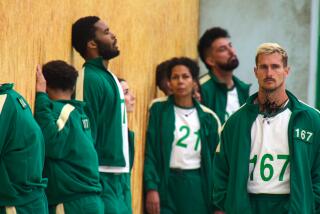Soaking Up Success
- Share via
The relationship between Hollywood and the video game industry has not always been smooth. With a few exceptions, games based on popular films often fall short. And films based on video games, such as “Super Mario Brothers” and “Mortal Kombat,” frequently have been critical disasters.
Amid this wreckage, THQ Inc.’s ties to Nickelodeon have been an exception. For one thing, the relationship has been profitable, generating more than $125 million in U.S. sales.
Their latest collaboration has resulted in “SpongeBob SquarePants: Legend of the Lost Spatula,” a Game Boy Color title based on Nickelodeon’s children’s cartoon series.
The show was the second-highest-ranking among kids during the first three months this year, trailing “Rugrats.” And the game, released in March, has consistently been among the top 10 Game Boy Color titles.
Created by Stephen Hillenburg, the show features a hapless sponge who lives at the bottom of the sea. Hillenburg, executive producer at Nickelodeon, talks about how he helped translate the TV property into a video game.
Q: How did the idea of creating a SpongeBob game come about? And what was your role in producing the game?
A: It was actually the network’s idea to do games. My role was to try to help out with elements in the show that could also work with the game. I also had to make sure that the main character in the game was in keeping with the main character of the show. SpongeBob is an innocent, so the character in the game had to retain that personality.
Q: How did you work with game designers at THQ?
A: Sometimes game designers needed different things from what we would need to tell a story. So we’d suggest things that they could work with. The game designers would say, “We need enemies. How about a shark?” And I’d point out that in the show, a shark would have to walk. All our characters walk. Also, a shark would be a bully, not a predator. So when they wanted a predator, I suggested using a giant clam. I would list what we would consider wild animals, such as bees that can sting. But for the most part, my ideas are already in the show. It’s not so much inventing something. It’s more like ferreting out things already in the show that would work in the game.
Q: Give us another example of how the show crossed over with the game.
A: Well, they need a vehicle. We said it just so happens that SpongeBob is a perennial student at a school for driving, and he can never seem to get his license. We also pointed out that they can only drive boats since they’re under water. We try to mine the logic of the show in a way that would be helpful. What helps is discussion. We find out what they need and come up with things that are in keeping with the show so that it’s fun to play.
Q: What are the differences in making a game versus an animated cartoon series?
A: Game makers look for a narrative, just like we would for a cartoon. Obviously, though, games need activity. They need to have a physical goal. Players need to search for something or pass through many obstacles. In a show, we focus more on humor. And we’re always looking for an emotional conflict, not necessarily an environmental one. We don’t usually write shows about SpongeBob combating an oil spill. It’s usually a relationship problem or personal conflict. There’s more character interaction in a show. Most of our stories come out of characters and their flaws. It’s just two different objectives. In the game, it’s about knocking things over and doing things. In the show, it’s more about the emotional challenge.
Q: How did you get the idea for SpongeBob in the first place?
A: My interest has always included marine science. I’ve always been fascinated with tide pool animals. So I started to think of all those weird marine invertebrates. A square sponge in a nautical world seemed like the right idea.
Q: How do you translate the show’s humor into the game?
A: Our show is not an educational show. It’s totally about humor--funny stories about funny characters. How you do that in a game is a challenge. A lot of it relies on saving the character’s personality. The game managed to keep SpongeBob silly and innocent, which is what he is. He keeps losing his pants, like a little kid. In the show, he has a range of weird facial expressions. If you can include that in the game, that would help make it funnier.
Q: What do you think of the game?
A: I think the guys who have been working on the game did a great job. They really captured the personalities of the characters, given the number of expressions that they can allow [in a hand-held game with limited resolution]. There were certain limitations for them and what they could do.
Q: Have you played the game?
A: Yeah, but I can’t get through many of the levels. I need a 10-year-old to come in and play the game in front of me.
*
Times staff writer Alex Pham covers the video game industry.
More to Read
The biggest entertainment stories
Get our big stories about Hollywood, film, television, music, arts, culture and more right in your inbox as soon as they publish.
You may occasionally receive promotional content from the Los Angeles Times.










